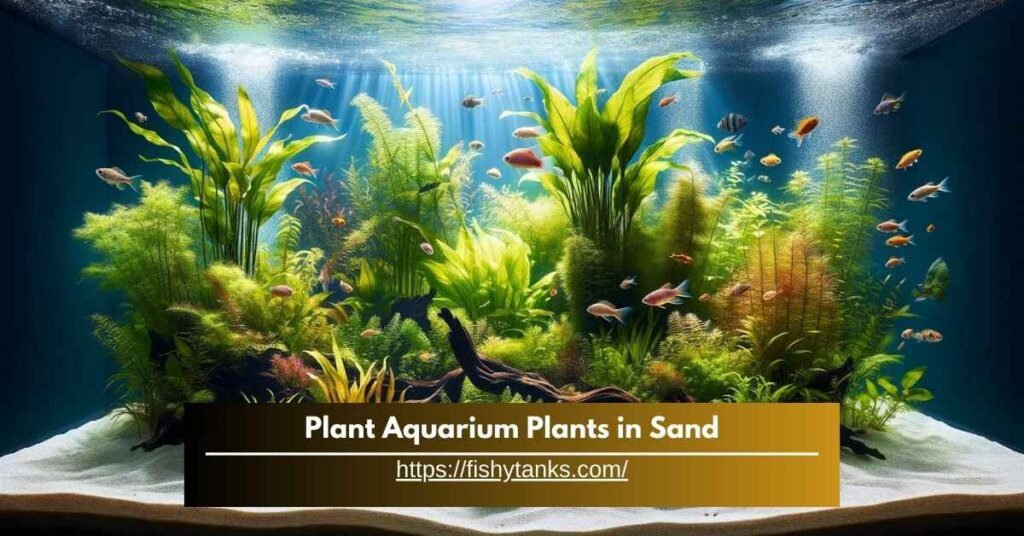Creating a lively underwater garden in your fish tank can be a fun and rewarding project. It adds beauty and makes a better home for your aquatic pets. Plant Aquarium Plants in Sand have their own challenges and benefits. This guide will show you how to plant aquarium plants in sand, helping them take root and grow well. You can turn your fish tank into a colorful underwater world by learning the right methods and choosing the right plants.

Choosing the Right Plants
Choosing the right aquarium plants is important for a healthy underwater garden. For a sand substrate, pick plants that are strong and can stay put in the fine sand.
Good choices are Java Fern, Anubias, and Cryptocoryne, because their roots adapt well and they are easy to care for.
Java Fern can be tied to rocks or driftwood, so it doesn’t rely much on the sand. Root-feeding plants like Amazon Swords can also work but may need extra nutrients to grow well in sand.
Check the lighting and water in your tank to select plants that fit the needs of your fish. By picking the right plants, you can create a balanced, colorful, and lasting underwater world.
Preparing the Sand Substrate
Before planting, you need to get the sand ready. First, rinse the sand well to get rid of any dirt or dust that could make the aquarium water cloudy.
Use a fine mesh strainer or colander to rinse the sand in small amounts. It’s also a good idea to soak the sand in water for a few hours. This helps remove any leftover dirt and keeps the sand from moving when you add plants.

Tools and Materials You’ll Need
- Fine-grained sand or aquarium plant substrate
- Aquarium-safe planting tweezers
- Scissors for trimming
- Plant weights or anchors (optional, for rooted plants)
- Water siphon or small hose for substrate cleaning
- Liquid fertilizers (optional, to promote plant growth)
Step-by-Step Process How to Plant Aquarium Plants in Sand
1. Prepare the Aquarium
Start by filling your aquarium with water to the desired level. This helps stabilize your sand substrate and makes planting easier.
2. Rinse the Sand
Thoroughly rinse the sand to remove any dust or debris. This step is crucial to avoid clouding your water when you fill the tank.
3. Create the Planting Area
Create a gentle slope or flat area in the sand, depending on the plant’s requirements. Some plants prefer a slight slope for better root development, while others do well in flat areas.
4. Plant the Aquatic Plants
Using aquarium tweezers, carefully plant the aquatic plants into the sand. Ensure the roots are buried, but the crown (the part where the plant stem meets the roots) is above the substrate. This promotes healthy growth and prevents rot.
5. Fill the Aquarium Slowly
Fill the aquarium with water slowly to avoid disturbing the newly planted plants. Pour water gently using a plate or dish to break the fall, minimizing disruption to the sand and plants.
6. Use Aquarium Fertilizer
Apply an aquarium fertilizer to provide essential nutrients for the plants. This helps them establish quickly and grow robustly.
7. Monitor the Plants
For the first few days, keep an eye on your plants to ensure they are adjusting well. Look for signs of stress or poor health, such as yellowing leaves or wilting, and adjust your care routine accordingly.

Best Plants for a Sand Aquarium
Picking the right plants for a sand aquarium is key to making a lively and healthy underwater scene. Some plants do well in sand and grow easily. Here are some of the top plants for a sand aquarium:
1. Anubias
Anubias is a tough and easy-care plant that grows well in different places. It doesn’t need rich soil and can be tied to rocks or wood. It grows slowly, making it great for any size aquarium.
2. Java Fern
Java Fern is also a great plant Aquarium plant in Sand. Like Anubias, you can attach it to decorations instead of planting it in the sand. This plant is easy to care for and can live in many water conditions, making it a favorite for beginners.
3. Cryptocoryne
Cryptocoryne, or “crypts,” are strong plants that grow well in sand. They have big root systems that settle nicely in sand. At first, they might look like they’re dying, but with good care, they usually recover and do well.
4. Vallisneria
Vallisneria, or “Val,” is a flexible plant that can grow in sand. It spreads by sending out runners and can quickly form a thick underwater field. Val plants like medium to high light, making them perfect for bright aquariums.
5. Amazon Sword
Amazon Sword is a beautiful plant that can be the main attraction in any fish tank. Its long roots go deep into the sand, helping it stay in place. This plant needs medium to bright light and sometimes root tabs to help it grow.
6. Sagittaria
Sagittaria is a tough, grass-like plant perfect for sandy bottoms. It grows fast and can make thick carpets, covering the aquarium floor well. This plant does well with medium light and can handle different water conditions.
7. Dwarf Hairgrass
Dwarf Hairgrass is a great choice for making a pretty carpet in a sand aquarium. It looks like fine grass and needs medium to strong light to grow well. Trimming it often helps it spread sideways, forming a thick, green carpet over time.

Planting Techniques
Plant Aquarium Plants in Sand require careful steps to help them grow strong roots and thrive. Start by gently washing the sand to remove any dust.
Next, make small holes in the sand using your finger or a tool. For plants like Amazon Swords or Cryptocoryne, which have big root systems, make sure the hole is deep enough for their roots.
Place the plant in the hole carefully, spread out the roots, and gently cover them with sand, leaving the top of the plant above the surface.
For plants like Java Fern and Anubias that do not need to be planted in the sand, you can tie them to rocks or driftwood with fishing lines or plant weights.
This keeps them in place and lets their roots attach naturally. After planting, avoid moving the plants so they can take root.
Watch their growth to ensure they are doing well in their new home. Regularly check the water conditions and provide the needed nutrients for healthy growth. With these simple steps, your underwater garden will grow beautifully in no time.
Common Challenges and Solutions
Planting in the sand has problems like plants floating, algae growing, and missing nutrients. You can fix these by using plant weights, controlling light times, adding algae-eating animals, and using liquid fertilizers or root tabs.
Mixing nutrient-rich soil with sand and having a deep sand layer helps roots grow. Frequent water changes and using fine filter media can clear cloudy water. Look for plants that grow well in sand or use pots with the right soil for picky plants.

Conclusion
Planting aquarium plants in sand can make your fish tank look better and healthier. By picking the right tools and following simple steps, you can help your plants grow well in their sandy home. Start by preparing the fine sand, use tweezers to plant carefully, keep the water clean, and give the plants the nutrients they need. Choose plants that grow well in sand to avoid problems and help them grow. With patience and regular care, your fish tank will turn into a beautiful, lively underwater scene that helps both your plants and fish.
FAQ’s
Q1. Can all plants grow in sand?
Not all aquarium plants grow well in sand. Some plants like Anubias, Java Fern, and Vallisneria do fine in sand, but others might have a hard time because sand doesn’t have many nutrients. It’s good to look up each plant to see if they can grow in sand, or you can add root tabs or a nutrient-rich layer under the sand to help them grow.
Q2. How do I prevent plants from floating in the sand?
To stop plants from floating in the sand, make sure their roots are buried deep in the ground. You can also use plant weights or anchors to keep them in place until their roots grow strong. Adding a small layer of gravel or small rocks can also help hold the plants down.
Q3. How often should I fertilize my sand-planted aquarium?
How often you fertilize depends on what your plants need and if there are fish in the tank. Usually, using liquid fertilizers once a week is a good start. Watch your plants for signs like yellow leaves or too much algae, and change the fertilizing schedule if needed.
Q4. What should I do if my water gets cloudy after planting?
Cloudy water often happens when planting in sand because tiny particles get mixed in. To make the water clear, change a bit of the water and use a fine filter to catch small particles. Over time, the particles will settle, and the cloudiness will go away. Regular care and not disturbing the sand too much will help keep the water clear.
Also Must Read More: How to Set Up a Saltwater Aquarium_ Simple Process



